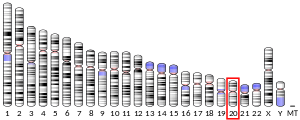CST2
Cystatin-SA is a protein that in humans is encoded by the CST2 gene.[3]
| CST2 | |||||||||||||||||||||||||
|---|---|---|---|---|---|---|---|---|---|---|---|---|---|---|---|---|---|---|---|---|---|---|---|---|---|
| Identifiers | |||||||||||||||||||||||||
| Aliases | CST2, cystatin SA | ||||||||||||||||||||||||
| External IDs | OMIM: 123856 GeneCards: CST2 | ||||||||||||||||||||||||
| |||||||||||||||||||||||||
| |||||||||||||||||||||||||
| Orthologs | |||||||||||||||||||||||||
| Species | Human | Mouse | |||||||||||||||||||||||
| Entrez |
| ||||||||||||||||||||||||
| Ensembl |
| ||||||||||||||||||||||||
| UniProt |
| ||||||||||||||||||||||||
| RefSeq (mRNA) |
| ||||||||||||||||||||||||
| RefSeq (protein) |
| ||||||||||||||||||||||||
| Location (UCSC) | Chr 20: 23.82 – 23.83 Mb | n/a | |||||||||||||||||||||||
| PubMed search | [2] | n/a | |||||||||||||||||||||||
| Wikidata | |||||||||||||||||||||||||
| |||||||||||||||||||||||||
The cystatin superfamily encompasses proteins that contain multiple cystatin-like sequences. Some of the members are active cysteine protease inhibitors, while others have lost or perhaps never acquired this inhibitory activity. There are three inhibitory families in the superfamily, including the type 1 cystatins (stefins), type 2 cystatins and the kininogens. The type 2 cystatin proteins are a class of cysteine proteinase inhibitors found in a variety of human fluids and secretions, where they appear to provide protective functions. The cystatin locus on chromosome 20 contains the majority of the type 2 cystatin genes and pseudogenes. This gene is located in the cystatin locus and encodes a secreted thiol protease inhibitor found at high levels in saliva, tears and seminal plasma.[3]
References
- GRCh38: Ensembl release 89: ENSG00000170369 - Ensembl, May 2017
- "Human PubMed Reference:". National Center for Biotechnology Information, U.S. National Library of Medicine.
- "Entrez Gene: CST2 cystatin SA".
External links
- The MEROPS online database for peptidases and their inhibitors: I25.009
- Human CST2 genome location and CST2 gene details page in the UCSC Genome Browser.
Further reading
- Brown WM, Dziegielewska KM (1997). "Friends and relations of the cystatin superfamily--new members and their evolution". Protein Sci. 6 (1): 5–12. doi:10.1002/pro.5560060102. PMC 2143511. PMID 9007972.
- Abrahamson M, Jonsdottir S, Olafsson I, et al. (1992). "Hereditary cystatin C amyloid angiopathy: identification of the disease-causing mutation and specific diagnosis by polymerase chain reaction based analysis". Hum. Genet. 89 (4): 377–80. doi:10.1007/BF00194306. PMID 1352269.
- Takahashi M, Honda Y, Ogawa K, Barka T (1993). "Immunofluorescence localization of cystatins in human lacrimal gland and in the exorbital lacrimal gland of the rat". Acta Ophthalmologica. 70 (5): 625–31. doi:10.1111/j.1755-3768.1992.tb02143.x. PMID 1471486.
- Isemura S, Saitoh E, Sanada K, Minakata K (1992). "Identification of full-sized forms of salivary (S-type) cystatins (cystatin SN, cystatin SA, cystatin S, and two phosphorylated forms of cystatin S) in human whole saliva and determination of phosphorylation sites of cystatin S". J. Biochem. 110 (4): 648–54. doi:10.1093/oxfordjournals.jbchem.a123634. PMID 1778989.
- Bobek LA, Aguirre A, Levine MJ (1991). "Human salivary cystatin S. Cloning, sequence analysis, hybridization in situ and immunocytochemistry". Biochem. J. 278 (3): 627–35. doi:10.1042/bj2780627. PMC 1151393. PMID 1898352.
- Abrahamson M, Olafsson I, Palsdottir A, et al. (1990). "Structure and expression of the human cystatin C gene". Biochem. J. 268 (2): 287–94. doi:10.1042/bj2680287. PMC 1131430. PMID 2363674.
- Levy E, Lopez-Otin C, Ghiso J, et al. (1989). "Stroke in Icelandic patients with hereditary amyloid angiopathy is related to a mutation in the cystatin C gene, an inhibitor of cysteine proteases". J. Exp. Med. 169 (5): 1771–8. doi:10.1084/jem.169.5.1771. PMC 2189307. PMID 2541223.
- Saitoh E, Sabatini LM, Eddy RL, et al. (1989). "The human cystatin C gene (CST3) is a member of the cystatin gene family which is localized on chromosome 20". Biochem. Biophys. Res. Commun. 162 (3): 1324–31. doi:10.1016/0006-291X(89)90818-8. PMID 2764935.
- Saitoh E, Isemura S, Sanada K, et al. (1989). "Cystatin superfamily. Evidence that family II cystatin genes are evolutionarily related to family III cystatin genes". Biol. Chem. Hoppe-Seyler. 369 Suppl: 191–7. PMID 3202964.
- Isemura S, Saitoh E, Sanada K (1988). "Characterization and amino acid sequence of a new acidic cysteine proteinase inhibitor (cystatin SA) structurally closely related to cystatin S, from human whole saliva". J. Biochem. 102 (4): 693–704. doi:10.1093/oxfordjournals.jbchem.a122107. PMID 3436950.
- Saitoh E, Kim HS, Smithies O, Maeda N (1988). "Human cysteine-proteinase inhibitors: nucleotide sequence analysis of three members of the cystatin gene family". Gene. 61 (3): 329–38. doi:10.1016/0378-1119(87)90196-X. PMID 3446578.
- Abrahamson M, Grubb A, Olafsson I, Lundwall A (1987). "Molecular cloning and sequence analysis of cDNA coding for the precursor of the human cysteine proteinase inhibitor cystatin C". FEBS Lett. 216 (2): 229–33. doi:10.1016/0014-5793(87)80695-6. PMID 3495457.
- Grubb A, Löfberg H (1982). "Human gamma-trace, a basic microprotein: amino acid sequence and presence in the adenohypophysis". Proc. Natl. Acad. Sci. U.S.A. 79 (9): 3024–7. doi:10.1073/pnas.79.9.3024. PMC 346341. PMID 6283552.
- Brzin J, Popovic T, Turk V, et al. (1984). "Human cystatin, a new protein inhibitor of cysteine proteinases". Biochem. Biophys. Res. Commun. 118 (1): 103–9. doi:10.1016/0006-291X(84)91073-8. PMID 6365094.
- Turk V, Brzin J, Longer M, et al. (1984). "Protein inhibitors of cysteine proteinases. III. Amino-acid sequence of cystatin from chicken egg white". Hoppe-Seyler's Z. Physiol. Chem. 364 (11): 1487–96. doi:10.1515/bchm2.1983.364.2.1487. PMID 6662498.
- Dickinson DP, Thiesse M, Dempsey LD, Millar SJ (1993). "Genomic cloning, physical mapping, and expression of human type 2 cystatin genes". Crit. Rev. Oral Biol. Med. 4 (3–4): 573–80. doi:10.1177/10454411930040034401. PMID 7690606.
- Dickinson DP, Zhao Y, Thiesse M, Siciliano MJ (1995). "Direct mapping of seven genes encoding human type 2 cystatins to a single site located at 20p11.2". Genomics. 24 (1): 172–5. doi:10.1006/geno.1994.1595. PMID 7896273.
- Thiesse M, Millar SJ, Dickinson DP (1994). "The human type 2 cystatin gene family consists of eight to nine members, with at least seven genes clustered at a single locus on human chromosome 20". DNA Cell Biol. 13 (2): 97–116. doi:10.1089/dna.1994.13.97. PMID 8179826.
- Janowski R, Kozak M, Jankowska E, et al. (2001). "Human cystatin C, an amyloidogenic protein, dimerizes through three-dimensional domain swapping" (PDF). Nat. Struct. Biol. 8 (4): 316–20. doi:10.1038/86188. PMID 11276250.


